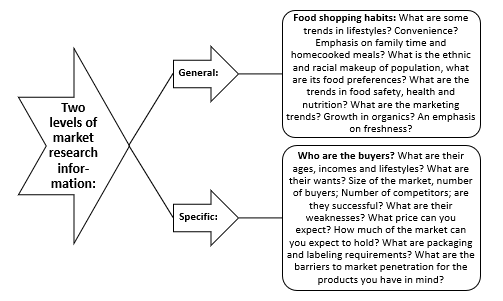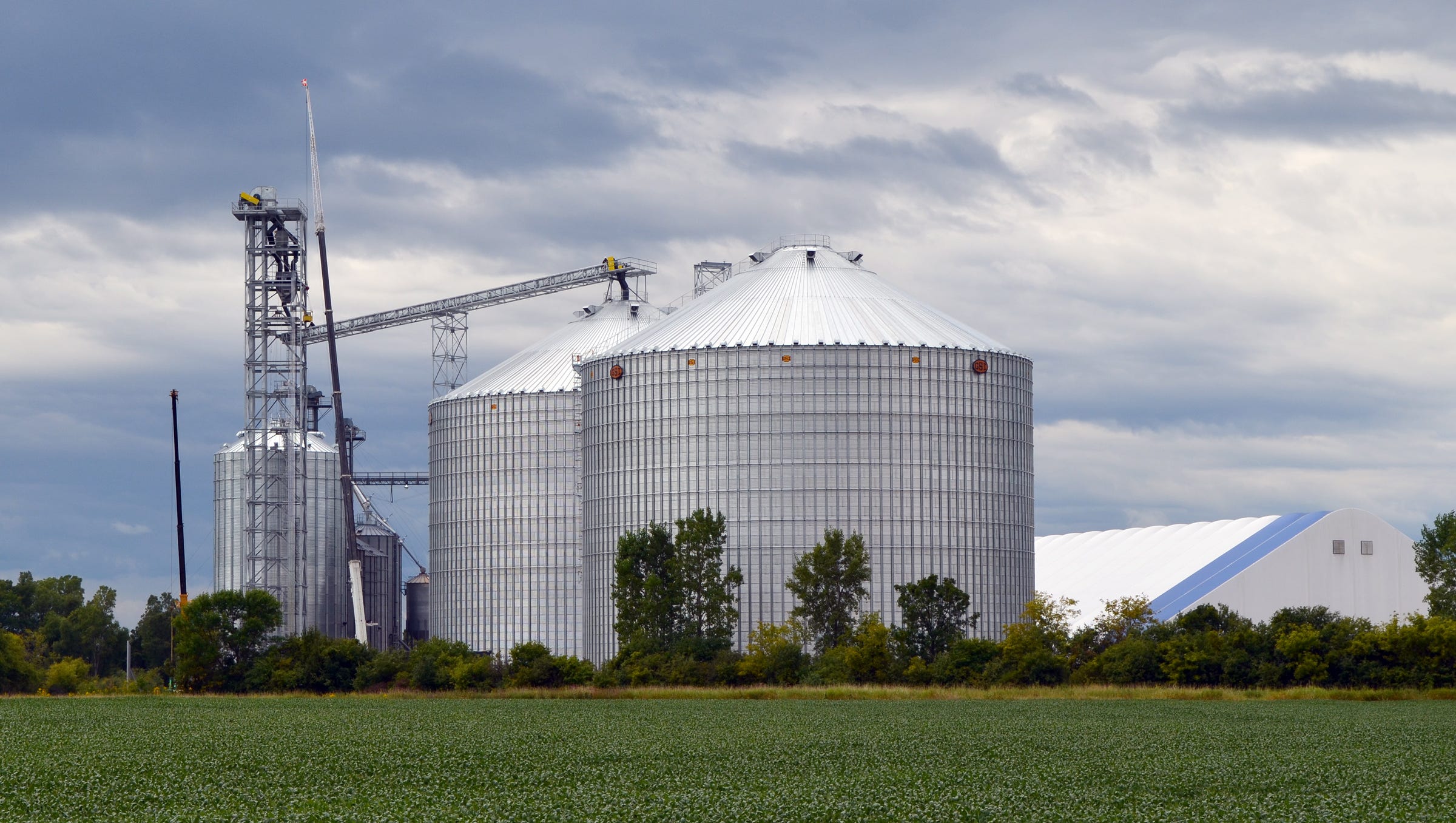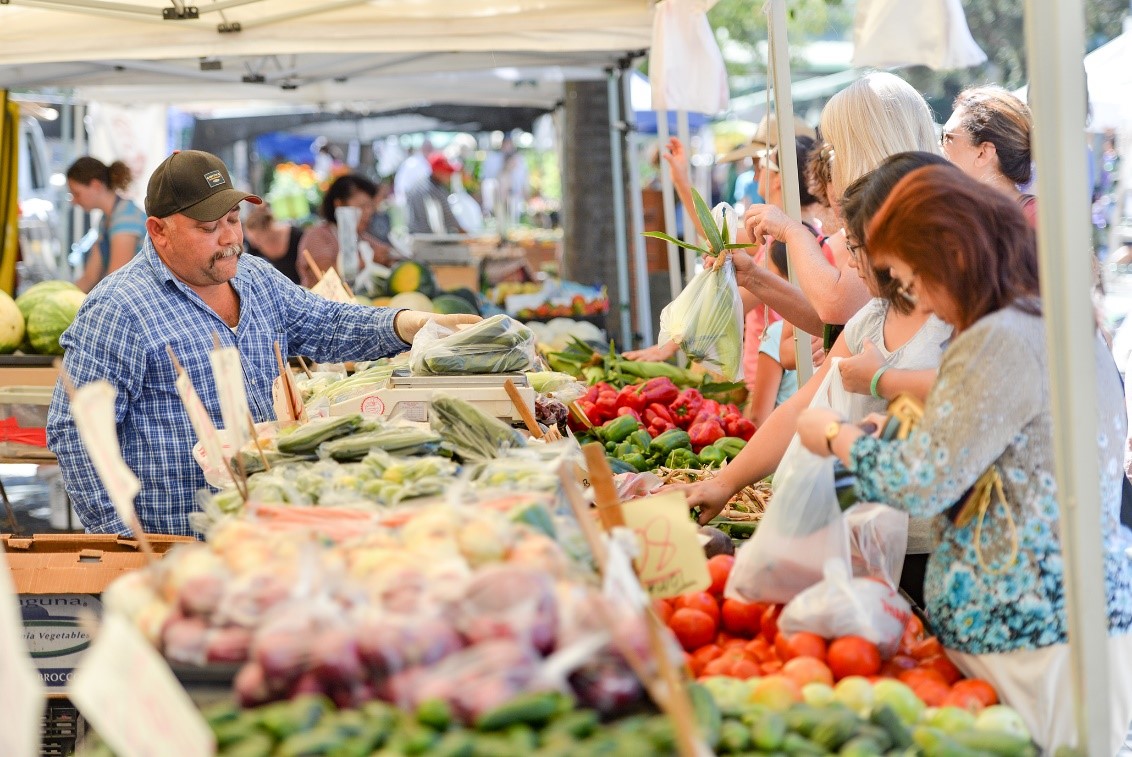
If you have decided to focus on the local market talk to your Extension Officer, visit the local shops (gourmet and otherwise) and supermarkets to see what is selling, and why one product appears more appealing than another. Talk to customers, local stores, food clubs, speciality distributors, restaurants and other prospective outlets in your region. What do they want? Is there an unfilled niche? With your production, labour and marketing resources, will you be able to fill this niche?
Find out what your prospective competitors are doing. Look for ways to improve upon what they are offering.
Information from market research helps to formulate a market strategy and project profitability. Two levels of information may be obtained:

You can either start small and grow bit by bit or you can start in a big way from the very beginning. Either way, you must be prepared to do your homework and get to know your markets to be successful.
Conventional marketing wisdom has it that 80% of sales come from 20% of the customer base. The grower must build a core customer base and let them know how important they are. Word-of-mouth advertising is the most effective and inexpensive way to attract new customers. Stay on top of consumer trends. The best-made product in the world will not sell if it isn't something people want.
Education of the consumer plays a big part in salesmanship. Most people, for instance, are oblivious to the environmental and health benefits of livestock raised on forage. Conveying information about the farm, how the product is raised and why it is raised the way it is, the effect of recent weather on the crops, and other farm-centred conversations are important. Not only is this good for business, but it also is a small step toward the development of consumer awareness of the farm and of social and health issues. Once customers know that you are providing healthy food, they gladly take on the responsibility to support local farmers. Help them help you run your business successfully and profitably.
Investigating International Market Opportunities

The export market is very important for South African agriculture. In theory, it should be very easy to determine demand. After all, there are numerous companies around the globe that conduct research and gather consumer data. This data would, for example, show that the consumption of oranges per person in EU countries has remained constant for the past 20 years, whereas in Japan it has increased. Add to this data about population growth and it should be quite easy to determine the market potential for a product in a given period. The complexity of determining future demand arises when one considers constantly changing consumer preferences for specific cultivars and types, the impact of competitive products, changes in disposable income, and other external factors.
The key to success lies in knowing the competition, understanding the impact of emerging trends on consumer behaviour, and being aware of consumer preferences in specific markets. This enables the most appropriate product to be supplied at the most appropriate time to differentiate your business from that of the competition.
With annual crops such as vegetables or grain, it is possible to change areas planted and crop type from year to year in response to predictions based on current and expected demand/supply balances. Other crops do not have the same flexibility. For example, citrus is a long-term crop. The productive lifespan of an orchard greatly exceeds the speed at which shifts in consumer trends, competitive actions and other factors impact demand. This means that sound decisions on what areas to plant, with what cultivars and in what ratios, should only be taken after analysing available market trends and extrapolating, interpreting and integrating such relevant information from a number of reliable sources.
However, short-term adjustments to supply patterns also have to be made based on prevailing and anticipated market forces within any particular season. This means that the producer has to contend with two sets of circumstances:
- He has to decide what volumes of fruit to send into the various export market segments within a specific season. In this context, the term ‘market segment’ is used broadly to cover differences between retail and wholesale markets within a single country as well as markets in different countries.
- He has to consider the development of long-term planting (production) and demand (market) trends of local and competing global citrus industries, or at least sectors of these industries.
In the first case, the production manager, through close liaison with his export agent, tracks weekly, if not daily, fruit supplies from other local producers and from competing countries and monitor the movement of this product into the markets in which he has an interest. He attempts to assess the quality and volumes of their product against his own supplies in the knowledge that oversupply weakens a market and influences perceptions about the quality of the product in that market. For example, when a market is fully supplied yet has confidence in the shelf-life and quality of the available fruit, demand is likely to remain firm. If, on the other hand, the market suspects that the condition of the product is deteriorating, demand will weaken as the market becomes increasingly pessimistic about the likely value of the product by the expected consumption date. This can lead to a downward spiral in market confidence in own and competitive products resulting in slow sales, the accumulation of increasingly poor-quality products and plummeting prices.
All such factors need to be taken into account by management to inform short-term decisions when switches of product supply into different market segments within a single production season are being considered.
Long-term demand/supply trends and extrapolations are used to inform long-term decisions, such as whether or not to channel resources into expansion or land acquisition actions given present and expected future changes to the operating environment. To arrive at such decisions strategic planning exercises are carried out.
Strategic planning is traditionally focused on setting the action plans to attain long-term objectives, taking into account current realities and expected future influencing factors. Successful strategic planning however requires information relating to both short-term influencing factors and long-term trends.
At the two extremes lie long-range strategic decision-making on the one hand, and ultra-short-term weekly adjustments to harvesting, delivery and distribution patterns aimed at optimising intra-seasonal returns, on the other. Somewhere in between lies the responsibility of the producer to certain opportunities that may arise and can be exploited. Such opportunities can come in the form of the opening of a new export market or a growing demand in certain market segments for organic or Fairtrade products.
Click here to view a video that explains the export markets for animal products.
Marketing Through Cooperative Structures- Pros and Cons and How it Works

There are two primary types of agricultural service cooperatives, supply cooperative and marketing cooperative. Marketing cooperatives are established by farmers to undertake the transformation, packaging, distribution, and marketing of farm products (both crop and livestock).
Cooperatives can add value to individual businesses and to the value chain as a whole by marketing the products of their member farmers. This is the ideal arrangement where individual farmers do not have the resources or knowledge to market their own products. In that case, they can pool resources and get the economies of scale that large agricultural businesses have, thereby overcoming the ‘curse of smallness’.
Producers and their cooperatives are selling into markets increasingly dominated by fewer, larger buyers. A variety of ownership and contractual arrangements intensifies concentration and creates a dramatic disparity in market power. Even the largest agricultural cooperatives have much smaller sales and asset bases than many of their competitors and customers. They have to seek added value for their members in other ways, for example, by identifying niche markets and focusing their marketing efforts on them.
Agricultural cooperative: Also known as a farmers' co-op, is a cooperative where farmers pool their resources in certain areas of activity.
There are other negative factors associated with cooperatives. Some issues arise because members vary in size and motivation. This makes it difficult to please all members. For example, commercial-scale producers may expect discounts on supply purchases and special services because such benefits are offered by other businesses. The costs of doing business through a multi-level supply cooperative come under real scrutiny when a farmer can order chemicals, for example, directly from the manufacturer and have them delivered for the less total cost.
In turn, small producers sometimes resist what they see as efforts by larger producer-members to control the organization. Large cooperatives may be inflexible and individual members may miss out on marketing opportunities because they are not able to respond to them in time because of their commitment to the cooperative.
Each member brings a specific set of interests and demands to the cooperative. Leaders and advisers of cooperatives must find ways to blend this diverse base of farmers into membership with a cohesive business interest in their cooperative.
Two themes permeate strategies for cooperatives to succeed in the 21st century. The first is that greater investment is needed in the people who make up cooperatives. Members, directors, managers, and advisers must receive the training required to deal with 21st-century issues. Otherwise, they will neither completely understand the options available nor have the ability to analyse them and make sound business decisions. The second is that an emphasis must be placed on pragmatism and profitability. Cooperatives are businesses and in the years ahead they must focus on solving business problems and providing value to their members. If they don't, members will stop patronizing them and they will just fade away.
Direct Selling from the Farm – Pro and Con’s

It is the excesses of the conventional marketing system that have forced the return of direct marketing. Consumers tired of tasteless supermarket produce and factory-raised meat (and with increasing concerns about food safety issues) want fresh food with flavour, as well as more control over their food supply, and are willing to pay a premium price for it.
Direct marketing can give the farmer a larger share of the food Rand and possibly a higher return on each unit sold, offset to some extent by loss of economies of scale. For some farmers, adding value or marketing some minimally processed farm products directly to the consumer is a way of enhancing financial viability. Farmers who are unable to compete in, or are locked out of, distant markets can build a thriving local business.
However, finding the right niche and marketing directly to the public is a hard and labour-intensive job requiring time and effort, creativity, ingenuity, sales expertise, and the ability to deal with people in a pleasant and positive manner. Agricultural producers must be absolutely sure they are ready for the job.
The one advantage that direct marketers have over retailers is the ability to build their relationships with customers over time. Indeed, good marketing is about building trust and personal loyalty in the relationship. Good sellers know and use the customer's name. Consumers who feel an emotional bond to the grower are likely to remain loyal, even though the product is available at the grocery store at a cheaper price.
Click here to download a handout to read more about other non-conventional markets.
Niche Markets

A niche market is the subset of the market on which a specific product is focusing; therefore, the market niche defines the specific product features aimed at satisfying specific market needs, as well as the price range, production quality and the demographics that is intended to impact.
Niche marketing is servicing a portion of a unique market, or a unique portion of a common market, not already served.
Click here to download a handout with examples of Niche Markets in Agriculture.